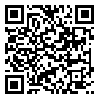Volume 15, Issue 3 (Aug & Sep 2021)
payavard 2021, 15(3): 291-302 |
Back to browse issues page
Ethics code: IR.TUMS.VCR.REC.1399.150
Download citation:
BibTeX | RIS | EndNote | Medlars | ProCite | Reference Manager | RefWorks
Send citation to:



BibTeX | RIS | EndNote | Medlars | ProCite | Reference Manager | RefWorks
Send citation to:
Gholamzadeh M, Ayyoubzadeh S M, Zahedi H, Rostam Niakan Kalhori S. Classification of Chest Radiology Images in Order to Identify Patients with COVID-19 Using Deep Learning Techniques. payavard 2021; 15 (3) :291-302
URL: http://payavard.tums.ac.ir/article-1-7001-en.html
URL: http://payavard.tums.ac.ir/article-1-7001-en.html
Marsa Gholamzadeh1 
 , Seyed Mohammad Ayyoubzadeh2
, Seyed Mohammad Ayyoubzadeh2 
 , Hoda Zahedi3
, Hoda Zahedi3 
 , Sharareh Rostam Niakan Kalhori *
, Sharareh Rostam Niakan Kalhori * 
 4
4

 , Seyed Mohammad Ayyoubzadeh2
, Seyed Mohammad Ayyoubzadeh2 
 , Hoda Zahedi3
, Hoda Zahedi3 
 , Sharareh Rostam Niakan Kalhori *
, Sharareh Rostam Niakan Kalhori * 
 4
4
1- Ph.D. Candidate in Medical Informatics, School of Allied Medical Sciences, Tehran University of Medical Sciences, Tehran, Iran
2- Ph.D. in Medical Informatics, School of Allied Medical Sciences, Tehran University of Medical Sciences, Tehran, Iran
3- Master of Sciences Student in Medical Informatics, School of Health Management and Information Sciences, Iran University of Medical Sciences, Tehran, Iran
4- Associate Professor, Department of Health Information Management, School of Allied Medical Sciences, Tehran University of Medical Sciences, Tehran, Iran; Research Fellow at Peter L. Reichertz Institute for Medical Informatics, University of Braunschweig–Institute of Technology and Hannover Medical School, Braunschweig, Germany ,Sh-rniakank@sina.tums.ac.ir
2- Ph.D. in Medical Informatics, School of Allied Medical Sciences, Tehran University of Medical Sciences, Tehran, Iran
3- Master of Sciences Student in Medical Informatics, School of Health Management and Information Sciences, Iran University of Medical Sciences, Tehran, Iran
4- Associate Professor, Department of Health Information Management, School of Allied Medical Sciences, Tehran University of Medical Sciences, Tehran, Iran; Research Fellow at Peter L. Reichertz Institute for Medical Informatics, University of Braunschweig–Institute of Technology and Hannover Medical School, Braunschweig, Germany ,
Abstract: (1851 Views)
Background and Aim: Due to the important role of radiological images for identifying patients with COVID-19, creating a model based on deep learning methods was the main objective of this study.
Materials and Methods: 15,153 available chest images of normal, COVID-19, and pneumonia individuals which were in the Kaggle data repository was used as dataset of this research. Data preprocessing including normalizing images, integrating images and labeling into three categories, train, test and validation was performed. By Python language in the fastAI library based on convolution technique (CNN) and four architectures (ResNet, VGG MobileNet, AlexNet), nine models through transitional learning method were trained to recognize patients from healthy persons. Finally, the performance of these models was evaluated with indicators such as accuracy, sensitivity and specificity, and F-Measure.
Results: Of the nine generated models, the ResNet101 model has the highest ability to distinguish COVID-19 cases from other cases with 95.29% sensitivity. Other applied models showed more than 96% accuracy in correctly diagnosis of various cases in test phase. Finally, the ResNet101 model was able to demonstrate 98.4% accuracy in distinguishing between healthy and infected cases.
Conclusion: The obtained accuracy showed the accurate performance of developed model in detecting COVID-19 cases. Therefore, by implementing an application based on the developed model, physicians can be helped in accurate and early diagnosis of cases. an application based on the developed model, physicians can be helped in accurate and early diagnosis of infected cases.
Materials and Methods: 15,153 available chest images of normal, COVID-19, and pneumonia individuals which were in the Kaggle data repository was used as dataset of this research. Data preprocessing including normalizing images, integrating images and labeling into three categories, train, test and validation was performed. By Python language in the fastAI library based on convolution technique (CNN) and four architectures (ResNet, VGG MobileNet, AlexNet), nine models through transitional learning method were trained to recognize patients from healthy persons. Finally, the performance of these models was evaluated with indicators such as accuracy, sensitivity and specificity, and F-Measure.
Results: Of the nine generated models, the ResNet101 model has the highest ability to distinguish COVID-19 cases from other cases with 95.29% sensitivity. Other applied models showed more than 96% accuracy in correctly diagnosis of various cases in test phase. Finally, the ResNet101 model was able to demonstrate 98.4% accuracy in distinguishing between healthy and infected cases.
Conclusion: The obtained accuracy showed the accurate performance of developed model in detecting COVID-19 cases. Therefore, by implementing an application based on the developed model, physicians can be helped in accurate and early diagnosis of cases. an application based on the developed model, physicians can be helped in accurate and early diagnosis of infected cases.
Keywords: Convolutional Neural Network, Coronavirus, COVID-19, Machine Learning, Deep Learning, Transfer Learning
Send email to the article author
| Rights and permissions | |
 |
This work is licensed under a Creative Commons Attribution-NonCommercial 4.0 International License. |



